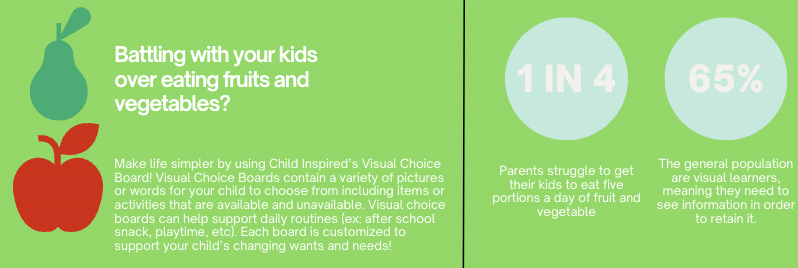Healthy Habits

“Vegetables, as part of an overall well-rounded diet, support many of our bodies’ systems and functions. Both fruits and vegetables are excellent sources of vitamins and minerals as well as fiber to help our digestive system” (Mikie Rangel, Registered Dietitian at Children’s Health). However, it’s no secret that getting children to eat fruit and vegetables can be a struggle at times! Children may refuse to try a fruit or vegetable because of its “yucky,” “gross,” or “weird” texture, smell, or color. Children may push their fruits or vegetables to the side of their plate. This often leads to frustration for parents or caregivers and meltdowns for children. This New Year, create healthy eating habits with child and kick the fruit and veggie battle to the curb with three simple recommendations!

1. Choice and voice!
Involve children in choosing fruits and vegetables. Participation and choice in fruits and vegetables helps create a sense of control for children. We can only control what we offer, so it is important to offer a variety of healthy fruits and vegetables. This includes how fruits and vegetables are served. “Roasting vegetables is a great way to brings out a caramelized flavor – season vegetables with a little salt before roasting to get a sweet and salty taste combination,” Rangel suggests. Children can learn to take responsibility for deciding what they are comfortable eating from the options offered. Child Inspired’s Visual Choice Board contains a variety of pictures or words for your child to choose from including items or activities that are available and unavailable (fruits, vegetables, toys, etc.). Visual choice boards can help support daily routines (ex: after school snack) and healthy habits (ex: trying new vegetables). Each visual choice board is laminated and includes pictures or words based on your child’s interests. Each folder contains additional pictures or words inside to be customized to support your child’s changing wants and needs!
2. Slow and steady!
Consistency is key. Make it routine to offer fruits or vegetables at each meal and focus on trying one fruit or vegetable one meal at a time (this includes snack time). Fruits and vegetables can be the star of the meal, a supporting player as a side dish, or a subtle add in (try adding veggies into your spaghetti sauce or berries into yogurt). Model eating fruits and vegetables. “Show your child the importance of a healthy diet by eating plenty of vegetables yourself,” says Rangel. Exposure to fruits and vegetables helps create a foundation of healthy eating habits.
3. Patience and positivity!
Stay positive! “No one wants to be forced to eat something they don’t want to eat. It’s ok to encourage your children to try something new but there should be no strings attached – no dessert deals or punishment pressures,” says Rangel. It is important to create an environment where children feel “pressure free” and comfortable to try different foods. Arguing about fruits and vegetables or forcing your child to eat one bite, creates the opposite effect. It gives more attention to the idea that fruits and vegetables are a pain and makes meal time a non-preferred activity. Instead, make fruits and vegetables fun. Offering vegetables with dips (hummus or dressing) and serving fruits in fun shapes and creative presentations (use cookie cutters or make rainbows out of fruit) help children get excited about trying new foods.
Keep the end-goal in mind: you want your child to have a healthy interest in a variety of foods and you want to enjoy meals together. Parents and caregivers remember ~ what your child eats does NOT define your success as a parent. Success looks different in every child!
Authored by Lexi Gooch: Child Inspired’s Family Education Specialist
 Lexi joined the Child Inspired practice in April 2023. Lexi received her B.S. in Early Childhood Education with dual certification in Special Education in 2019 and her M.Ed. in Special Education in 2020 at Eastern University. Lexi currently works full-time in the Cape Henlopen School District for the Sussex Consortium at Love Creek Elementary School. Lexi has developed and implemented Individualized Education Plans to best support students’ individual needs. Lexi has also developed child-centered lesson plans in the areas of literacy, math, science, and social studies accommodating students and utilizing a variety of instructional methods. Lexi has demonstrated mastery in the nine elements of the Pyramid Approach to Education model and is a certified Teacher of Students with Autism or Students with Severe Intellectual Disabilities. Lexi is also trained in the Picture Exchange Communication System. Lexi is a positive advocate for inclusive learning environments and experiences for children and families with a variety of needs. Lexi has a passion for working with children and developing a partnership with families to support children both at school and at home. As a former field hockey player and field hockey coach, Lexi understands the value of teamwork and applies this knowledge and experience to her approach to working with children and families. Lexi’s responsibilities within Child Inspired include developing and implementing therapeutic and educational groups, workshops, and trainings; building out online family resources; and developing programs to support the needs of our broader community. Lexi brings creative energy and innovative ideas to the Child Inspired practice.
Lexi joined the Child Inspired practice in April 2023. Lexi received her B.S. in Early Childhood Education with dual certification in Special Education in 2019 and her M.Ed. in Special Education in 2020 at Eastern University. Lexi currently works full-time in the Cape Henlopen School District for the Sussex Consortium at Love Creek Elementary School. Lexi has developed and implemented Individualized Education Plans to best support students’ individual needs. Lexi has also developed child-centered lesson plans in the areas of literacy, math, science, and social studies accommodating students and utilizing a variety of instructional methods. Lexi has demonstrated mastery in the nine elements of the Pyramid Approach to Education model and is a certified Teacher of Students with Autism or Students with Severe Intellectual Disabilities. Lexi is also trained in the Picture Exchange Communication System. Lexi is a positive advocate for inclusive learning environments and experiences for children and families with a variety of needs. Lexi has a passion for working with children and developing a partnership with families to support children both at school and at home. As a former field hockey player and field hockey coach, Lexi understands the value of teamwork and applies this knowledge and experience to her approach to working with children and families. Lexi’s responsibilities within Child Inspired include developing and implementing therapeutic and educational groups, workshops, and trainings; building out online family resources; and developing programs to support the needs of our broader community. Lexi brings creative energy and innovative ideas to the Child Inspired practice.
